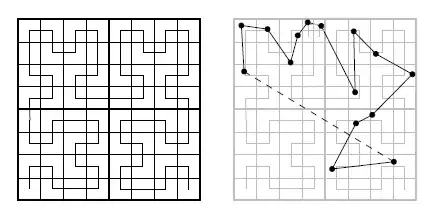To find the squares which contains a point, the search domain, i.e. a collection of points, conceptually must contain retrievable attributes, such as number of points, whether a point is to be visited, and even the order in which a point will be visited. An array of a simple struct comes to mind as one implementation that could be used to model such a domain.
in C for example:
typedef struct {
int x; //x position in domain
int y; //y position in domain
}P; //point
typedef struct {
P p;
BOOL occupied; //1 = will be visited, 0 = will NOT be visited
int sequence; //0 if not visited, 1-n indicated order of visit.
}DOMAIN; // example points: {{0, 0}, 1, 1}, {{0, 1}, 0, 0}
// meaning: The point at position 0,0 will be visited first
// The point at position 0,1 will not be visited.
//Model of some existing domain using the DOMAIN struct.
//This one is comprised of 25 points, arranged in 5x5 square,
//but if a domain of different dimensions is required, (and can
//be represented in this fashion) modify these initializers to
//meet those needs:
DOMAIN domain[] = {{{0,0},1,1},{{0,1},0,-1},{{0,2},0,-1},{{0,3},0,-1},{{0,4},0,-1},
{{1,0},0,-1},{{1,1},0,-1},{{1,2},0,-1},{{1,3},0,-1},{{1,4},0,-1},
{{2,0},0,-1},{{2,1},1,2},{{2,2},0,-1},{{2,3},0,-1},{{2,4},0,-1},
{{3,0},0,-1},{{3,1},0,-1},{{3,2},0,-1},{{3,3},1,3},{{3,4},0,-1},
{{4,0},0,-1},{{4,1},1,4},{{4,2},0,-1},{{4,3},0,-1},{{4,4},1,5} };
int main(void)
{ //Get the total number of points existing in domain:
int pointCount = sizeof(domain)/sizeof(domain[0]);
int i;
for(i=0;i<pointCount;i++)
{ //determine point by point which are to be occupied...
if(domain[i].occupied == TRUE)
{ //For any point to be occupied, indicate its location
//and in what order (sequence) it will be occupied.
printf("point[%d,%d] is occupied with sequence %d\n", domain[i].p.x,domain[i].p.y, domain[i].sequence);
}
}
return 0;
}
The results of this domain, with points that will be occupied, and the order of occupation:


